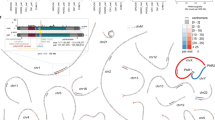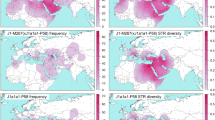Abstract
A genome is a mosaic of chromosome fragments from ancestors who existed some arbitrary number of generations earlier. Here, we reconstruct the genome of Hans Jonatan (HJ), born in the Caribbean in 1784 to an enslaved African mother and European father. HJ migrated to Iceland in 1802, married and had two children. We genotyped 182 of his 788 descendants using single-nucleotide polymorphism (SNP) chips and whole-genome sequenced (WGS) 20 of them. Using these data, we reconstructed 38% of HJ’s maternal genome and inferred that his mother was from the region spanned by Benin, Nigeria and Cameroon.
This is a preview of subscription content, access via your institution
Access options
Access Nature and 54 other Nature Portfolio journals
Get Nature+, our best-value online-access subscription
$29.99 / 30 days
cancel any time
Subscribe to this journal
Receive 12 print issues and online access
$209.00 per year
only $17.42 per issue
Buy this article
- Purchase on Springer Link
- Instant access to full article PDF
Prices may be subject to local taxes which are calculated during checkout






Similar content being viewed by others
References
Helgason, A. et al. mtDNa and the islands of the North Atlantic: estimating the proportions of Norse and Gaelic ancestry. Am. J. Hum. Genet. 68, 723–737 (2001).
Jónsson, G. & Magnússon, M. S. Hagskinna: Icelandic Historical Statistics (Statistics Iceland, 1997).
Palsson, G. The Man Who Stole Himself: The Slave Odyssey of Hans Jonathan (University of Chicago Press, 2016).
Price, A. L. et al. Sensitive detection of chromosomal segments of distinct ancestry in admixed populations. PLoS Genet. 5, e1000519 (2009).
International HapMap Consortium. The International HapMap Project. Nature 426, 789–796 (2003).
Helgason, A., Nicholson, G., Stefánsson, K. & Donnelly, P. A reassessment of genetic diversity in Icelanders: strong evidence from multiple loci for relative homogeneity caused by genetic drift. Ann. Hum. Genet. 67, 281–297 (2003).
Alexander, D. H., Novembre, J. & Lange, K. Fast model-based estimation of ancestry in unrelated individuals. Genome Res. 19, 1655–1664 (2009).
Jagadeesan, A. et al. Linked open-access data supporting this article, including but not limited to the data items separately cited as other references https://doi.org/10.6084/m9.figshare.5640985 (2017).
Gudbjartsson, D. F. et al. Large-scale whole-genome sequencing of the Icelandic population. Nat. Genet. 47, 435–444 (2015).
1000 Genomes Project Consortium et al. A global reference for human genetic variation. Nature 526, 68–74 (2015).
Baran, Y. et al. Fast and accurate inference of local ancestry in Latino populations. Bioinformatics 28, 1359–1367 (2012).
Karafet, T. M. et al. New binary polymorphisms reshape and increase resolution of the human Y chromosomal haplogroup tree. Genome Res. 18, 830–838 (2008).
Eltis, D. & Richardson, D. The Trans-Atlantic Slave Trade Database http://www.slavevoyages.org/ (2010).
Jagadeesan, A. et al. PCA plots with African reference populations https://doi.org/10.6084/m9.figshare.5640937 (2017).
Lawson, D. J. & Falush, D. Population identification using genetic data. Annu. Rev. Genomics Hum. Genet. 13, 337–361 (2012).
Busby, G. B. et al. Admixture into and within sub-Saharan Africa. eLife 5, e15266 (2016).
Bryc, K. et al. Genome-wide patterns of population structure and admixture in West Africans and African Americans. Proc. Natl. Acad. Sci. USA 107, 786–791 (2010).
Gurdasani, D. et al. The African Genome Variation Project shapes medical genetics in Africa. Nature 517, 327–332 (2015).
Pagani, L. et al. Ethiopian genetic diversity reveals linguistic stratification and complex influences on the Ethiopian gene pool. Am. J. Hum. Genet. 91, 83–96 (2012).
Patin, E. et al. The impact of agricultural emergence on the genetic history of African rainforest hunter-gatherers and agriculturalists. Nat. Commun. 5, 3163 (2014).
Schlebusch, C. M. et al. Genomic variation in seven Khoe-San groups reveals adaptation and complex African history. Science 338, 374–379 (2012).
Tishkoff, S. A. et al. The genetic structure and history of Africans and African Americans. Science 324, 1035–1044 (2009).
Jagadeesan, A. et al. MDS plots with African reference populations (Affymetrix) https://doi.org/10.6084/m9.figshare.5640934 (2017).
Jagadeesan, A. et al. MDS/PCA plots within West Africa https://doi.org/10.6084/m9.figshare.5640931 (2017)
Sankararaman, S. et al. The genomic landscape of Neanderthal ancestry in present-day humans. Nature 507, 354–357 (2014).
Kong, A. et al. Detection of sharing by descent, long-range phasing and haplotype imputation. Nat. Genet. 40, 1068–1075 (2008).
Hinch, A. G. et al. The landscape of recombination in African Americans. Nature 476, 170–175 (2011).
Palamara, P. F. et al. Leveraging distant relatedness to quantify human mutation and gene-conversion rates. Am. J. Hum. Genet. 97, 775–789 (2015).
Barton, N. H. & Etheridge, A. M. The relation between reproductive value and genetic contribution. Genetics 188, 953–973 (2011).
Kong, A. et al. A high-resolution recombination map of the human genome. Nat. Genet. 31, 241–247 (2002).
Jagadeesan, A. et al. Relatedness among HJ’s descendants https://doi.org/10.6084/m9.figshare.5640982 (2018).
Howie, B. N., Donnelly, P. & Marchini, J. A flexible and accurate genotype imputation method for the next generation of genome-wide association studies. PLoS Genet. 5, e1000529 (2009).
Jagadeesan, A. et al. Filtering HAPMIX inferred African fragments https://doi.org/10.6084/m9.figshare.5640868 (2018).
Jonsson, T. et al. A mutation in APP protects against Alzheimer’s disease and age-related cognitive decline. Nature 488, 96–99 (2012).
Petersen, D. C. et al. Complex patterns of genomic admixture within southern Africa. PLoS Genet. 9, e1003309 (2013).
Fortes-Lima, C. et al. Genetic population study of Y-chromosome markers in Benin and Ivory Coast ethnic groups. Forensic Sci. Int. Genet. 19, 232–237 (2015).
Jagadeesan, A. et al. Reference populations https://doi.org/10.6084/m9.figshare.5640796 (2018).
López Herráez, D. et al. Genetic variation and recent positive selection in worldwide human populations: evidence from nearly 1 million SNPs. PLoS One 4, e7888 (2009).
Xing, J. et al. Toward a more uniform sampling of human genetic diversity: a survey of worldwide populations by high-density genotyping. Genomics 96, 199–210 (2010).
Acknowledgements
A.J., H.J. and C.F.-L. were funded by the EUROTAST Marie Curie Framework Programme 7 Initial Training Network 290344). We thank all the members of EUROTAST network for their helpful comments and suggestions. S.S.E. and V.B.G. received grants from The Research Fund of University of Iceland for doctoral studies. M.S.E. received a grant from the Icelandic Research Fund (163428-051).We thank E. Soumonni, a historian whose advice guided the recruitment of Beninese individuals, and J.-P. Chippaux (CERPAGE, Cotonou, Benin) for his help with local authorities.
Author information
Authors and Affiliations
Contributions
A.J., K.S. and A.H. planned and directed the research. A.J. and A.H. analyzed the data, with A.K., E.D.G., S.S.E., V.B.G., E.L.T., M.S.E., H.J. and G.M. providing assistance with particular tasks. A.J., K.S. and A.H. wrote the paper. J.-M.D., C.F.-L., F.M.-N., A.M., G.B. and L.P. provided data for reference samples from African populations and helped with population structure analysis.
Corresponding authors
Ethics declarations
Competing interests
Some authors affiliated with deCODE Genetics are employed by the company, which is owned by Amgen, Inc.: A.J., E.D.G., S.S.E., V.B.G., E.L.T., H.J., G.M., A.K., K.S. and A.H.
Additional information
Publisher’s note: Springer Nature remains neutral with regard to jurisdictional claims in published maps and institutional affiliations.
Supplementary information
Rights and permissions
About this article
Cite this article
Jagadeesan, A., Gunnarsdóttir, E.D., Ebenesersdóttir, S.S. et al. Reconstructing an African haploid genome from the 18th century. Nat Genet 50, 199–205 (2018). https://doi.org/10.1038/s41588-017-0031-6
Received:
Accepted:
Published:
Issue Date:
DOI: https://doi.org/10.1038/s41588-017-0031-6



